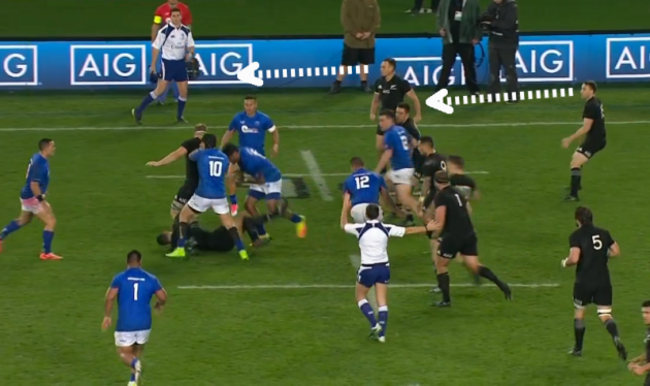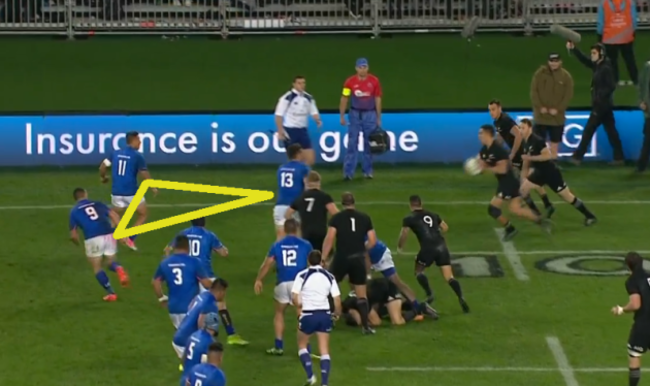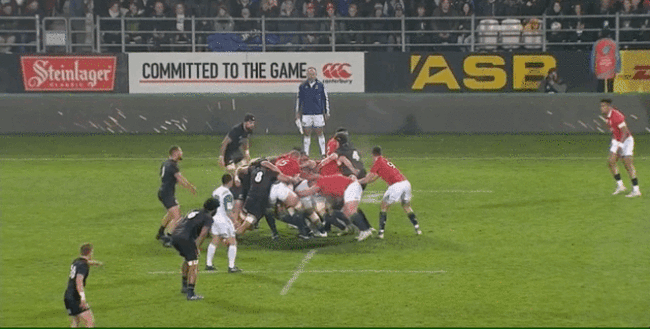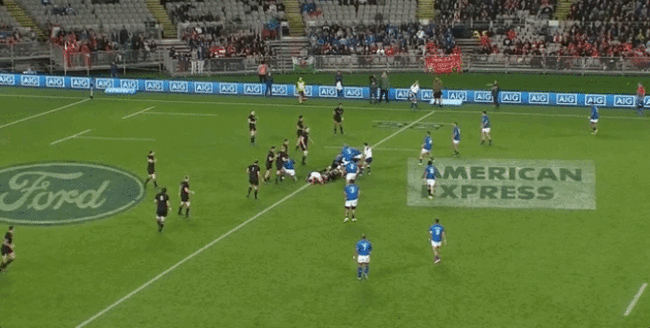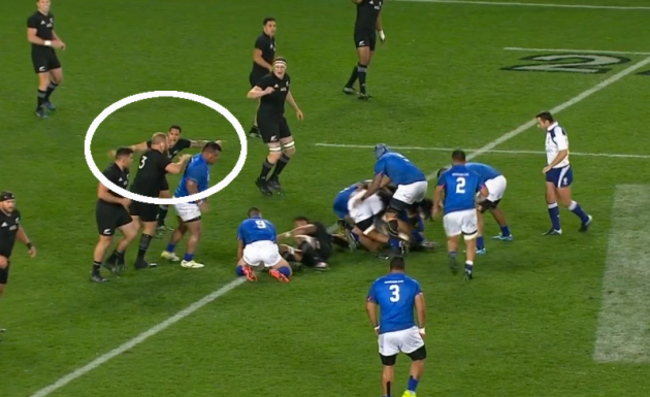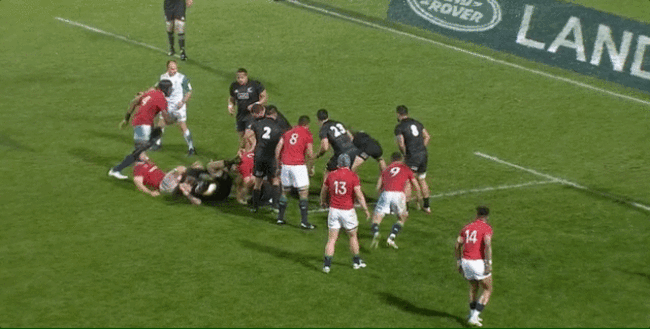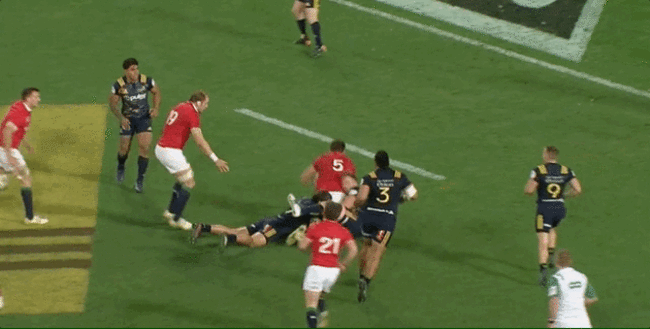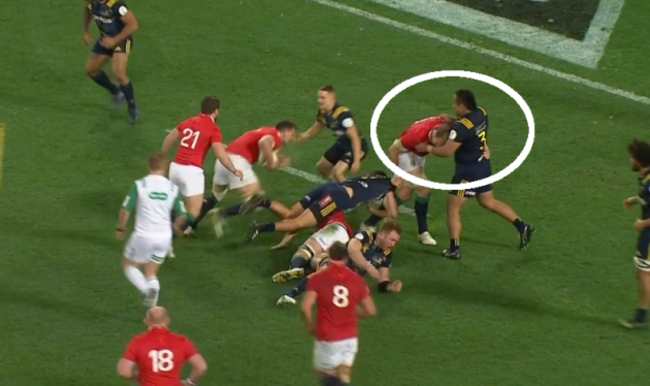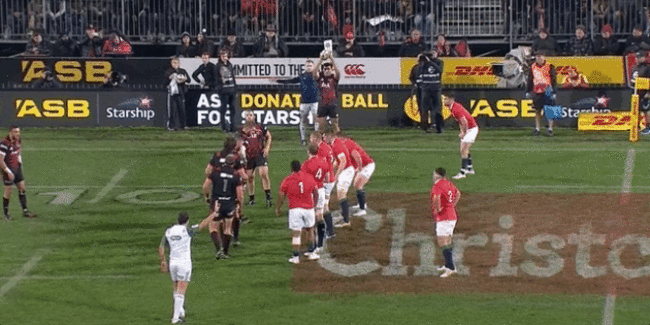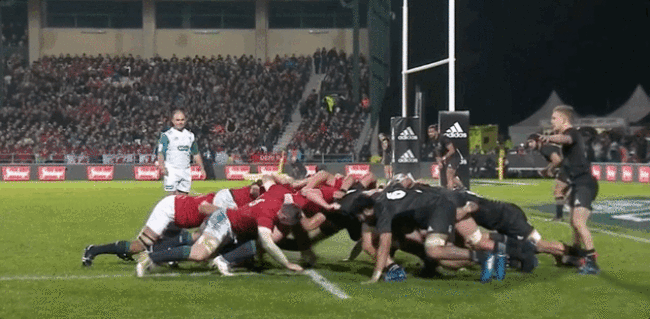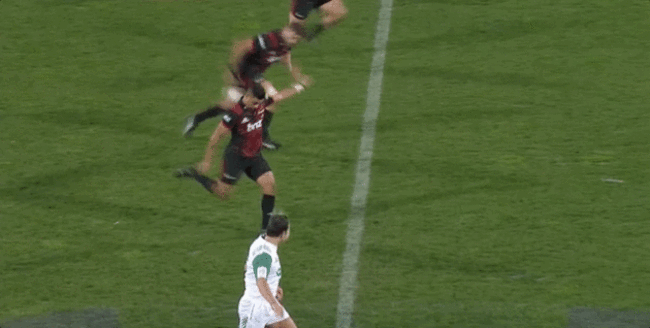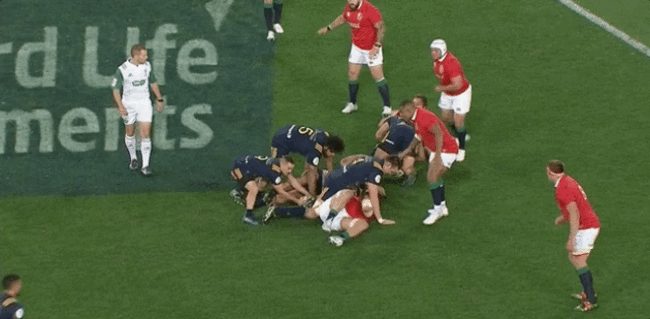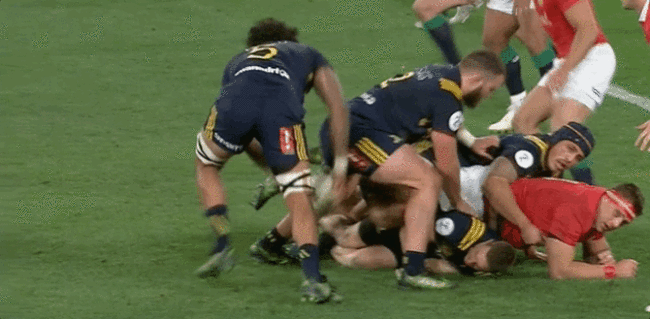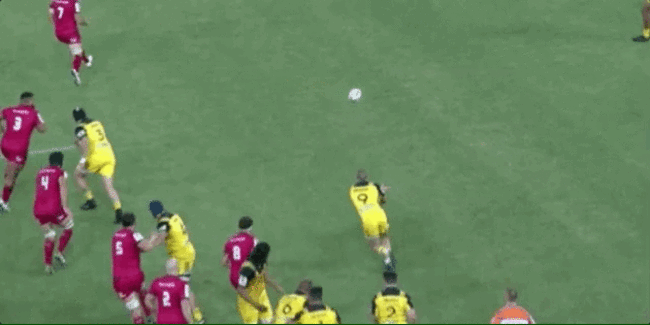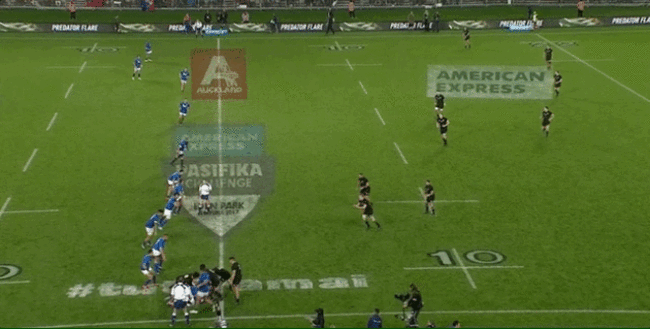Murray Kinsella reports from Auckland
MONTHS AND MONTHS of build-up, bitching, hype and hope are almost at an end and today the Lions and All Blacks will finally play the first Test of their three-game series in New Zealand.
Ahead of the huge clash in Auckland, we’ve taken a look at some of the key tactical areas where the contest could be won and lost.
All Blacks in transition
Make basic errors against the All Blacks and they will punish you; it’s simple.
The ‘transition’ areas were always going to be the biggest challenge for the Lions on this tour. The Kiwis thrive in unstructured passages of play – turnover possession and kick return – and are very comfortable in ‘chaos.’
They spent great amounts of training time on this part of the game and it is the greatest source of their tries.
The Lions will have spent great amounts of time working on their ability to react to their own errors and transition from attack into defence with composure and organisation, but even still it a huge task to stop the utterly ruthless All Blacks.
In the instance above, from last weekend’s 78-0 win over Samoa, the Pacific Islanders knock the ball on in the carry and the All Blacks are immediately thinking ‘opportunity’ – they have a try-scoring mentality on turnover possession.
We can see that Israel Dagg and Ben Smith instantly have their heads up scanning for where the opportunity is.
While the initial call appears to be for Smith to kick low and deep behind the Samoans for those outside backs to run onto, Anton Lienert-Brown fades off to join them in the narrow blindside channel and the scrum-half feeds him the ball.
Uncomfortable in the transition, Samoa’s three defenders all do different things, even with only five metres of lateral space to defend.
Kahn Fotuali’i [9] looks to sweep deep for the kick, Tim Nanai Williams [11] sits off close to the touchline, and Kieron Fonotia [13] drifts towards Lienert-Brown without applying any pressure.
It’s an invitation and Lienert-Brown beats Fonotia in a one-on-one situation with ease, glides past Nanai Williams and then shows the kind of creative skills Kiwi players possess in bucketloads to pass around the back of Fotuali’i for Dagg to score.
Obviously, the Lions have to be ultra-accurate with their handling and kicking to prevent these kind of unstructured scenarios being presented to the All Blacks’ attack, but it would be no surprise to see Hansen’s men score from kick return or turnover possession.
This is where their catch-pass, vision, offloading, support play and decision-making skills prove so effective.
Lions boxing on Ioane
The Lions have averaged 25 kicks per game on this tour and – like any good team in rugby – kicking will be important for them at Eden Park.
While Owen Farrell and Conor Murray will both be looking for space deep in the backfield, the scrum-half’s contestable box kicks are a genuine weapon for the Lions too.
Making his first start on the left wing for the All Blacks, 20-year-old Rieko Ioane can expected to be severely tested, particularly after showing a hint of hesitance last weekend in Rotorua.
Conor Murray launches his kick from the back of another superb Lions maul here, and the quality of the kick is worth commenting on.
Generally speaking, scrum-halves are looking to get around 20 metres of distance and at least four seconds of hang time on their kicks if their team-mates are going to be able to get off the ground and compete in the air.
Murray achieves exactly that – dropping the ball in pinpoint fashion just in front of the 22 to remove Ioane’s option of a ‘mark’ call – and Watson’s chase is equally impressive.
The Lions have had issues with their chasers being shepherded off the ball – more of which below – but Watson is assertive and aggressive in this instance.
Elliot Dixon and then Tawera Kerr-Barlow [as indicated by white below] both look to slow Watson’s progress on the chase.
But in his determination to pressure Ioane, Watson doesn’t accept being impeded. He stays big and strong, shouldering through and beyond both of the ‘kick escorts’ who are looking to protect Ioane [circled in red].
Watson gets through and he is able to get off the deck – even though Damian McKenzie adds in a third subtle block – adding another stress for Ioane as he looks to make a clean catch.
The Blues wing loses his nerve under the high ball and spills forward, where his brother Akira attempts to claim the ball in an offside position, with the Lions winning the penalty and slotting three points.
While there is no doubt that Rieko Ioane could score a hat-trick today if he is given the space and possession, the freakish athlete will be under scrutiny from the Lions’ kicking game.
Smith on the fringes
One opportunity that the Lions will have identified is familiar to Ireland fans. Aaron Smith is a hugely important defensive organiser for the Kiwis, but he is not as quick to plug holes as Conor Murray.
While Murray loves getting into the line and using his frame to make big hits, Smith often directs others to fill in gaps around the fringes of rucks.
As we saw for Murray’s sniping try against New Zealand in Chicago last November, that can cause problems and slight confusion, especially for slower-reacting front row players.
Below, we get another example against Samoa last weekend.
Samoa are in the midst of a series of narrow carries, and Owen Franks [3] is slow to fold from the right side of the ruck to the left after Brodie Retallick calls for extra bodies there.
Rather than plugging that spot himself, Smith directs Franks to do so.
Samoa prop Viliamu Afatia impedes Franks initially and it means Franks is slow into the ‘pillar’ position on the left of the ruck, allowing Manu Leiataua to get a good latch onto ball carrier Piula Faasalele for notable gains.
Smith and Franks were the players directly involved for Murray’s try against the All Blacks in November, and there are a number of similar examples across their fixtures in the last year.
Smith’s positioning allows him to sweep well to cover wide channels and chip/grubber space behind the frontline, while his communication is important too, but the Lions will be biding their time and waiting for their opportunity to pounce at the fringes.
Gatland’s call
Kick escorting, shepherding, blocking, obstruction, cheating – call it what you want, everyone in rugby is at it.
When a high ball goes into the air, it is the duty of the players in front of the fielding player to make life as easy for them as possible. That means impeding chasing players as subtly as possible, preventing them from applying pressure on the fielding player.
Warren Gatland has raised the ante by calling on the referees to cut it out of the Tests. The Lions boss might get more than he bargained for.
We’ll call it now – a contentious penalty for some kind of holding, blocking or obstruction will have an important part in today’s game. Referee Jaco Peyper and his team of match officials will be on red-hot alert in this area of the game.
Even in the Māori All Blacks game we saw and heard evidence of the increased focus, with the match officials constantly reminding each other to look out for off-the-ball penalties within the kicking battle.
The Lions won a penalty in the instance above for Nehe Milner-Skudder’s blocking on George North as he looked to chase Murray’s kick.
It was far from an isolated incident.
We can see a rather blatant block from James Lowe [15] on Murray in the example above, giving McKenzie more time to exit.
Spotting this stuff live is obviously difficult for the match officials and they will be tuned in today. But that will come down on both the All Blacks and the Lions, who use these kind of tactics themselves – as do all good rugby teams.
By making the issue a public one, Gatland has also placed a good degree of pressure on Peyper and co. to flag up all similarly subtle actions.
That could come back to haunt the Lions, even if it’s not directly in this area of blocking players in the kicking battle.
Watch the wily Alun Wyn Jones in the incident above, as Sam Warburton scores a try against the Highlanders.
Wales lock Jones steps over the breakdown and up beyond it, wrapping up Highlanders prop Siate Tokolahi, who is attempting to fold around to the far side.
By tying Tokolahi in, Jones creates space for Warburton to pick and drive into, as he easily wins a one-on-one contest with scrum-half Kane Hammington to touch down under the posts.
Today’s officials will be watching out for this kind of play – and the blocking – like hawks, and it’s not difficult to see some big calls being made on the TMO review. Whether they go for or against Gatland’s Lions remains to be seen.
Lions’ set-piece
We don’t need to dwell on this element of the game for too long, but it’s already clear that the Lions will be counting on their scrum, lineout and maul to deliver.
In George Kruis, they have a superb lineout caller, while Jamie George is one of the best throwers in the world. Interestingly, the Saracens pair have had a connection at lineout time since they were 18 and we can expect a strong link there again.
Defensively, captain Peter O’Mahony will lead the charge as the Lions look to limit quality set-piece possession for the All Blacks, who showed how lethal they are with clean ball against Samoa last weekend.
We see O’Mahony’s ability to read the opposition in the example above against the Crusaders, as well as his unique leaping power off the ground.
Ireland got at the All Blacks’ lineout in Chicago in November and it proved to be a major reason for their win, although Retallick and Sam Whitelock were both missing that day.
O’Mahony was missing too, however, and it should prove to be a riveting battle out of touch today as the Lions look to assault the All Blacks’ lineout.
On their own throw, expect to see plenty of driven ball from the Lions, particularly early in the game, with the likes of Kruis, Jones, Tadhg Furlong and O’Mahony all being excellent maul players – both in attack and defence.
Of course, the Lions’ scrum is in a good place coming into this game too, having notched a penalty try last weekend in Rotorua – and with Peyper refereeing.
Furlong, George and Mako Vunipola have been excellent in the front row during the warm-up games, but it’s worth pointing out the eight-man shove in this instance, with the entire pack patient, biding their time before a cohesive drive.
While many are anticipating that the Lions will have dominance in this area, the All Blacks should not be underestimated. With the respected scrum coach Mike Cron behind their efforts, the Kiwis are more than capable of fronting up.
It would be no surprise to see the scrum contest become a scrappy one, although it must be hoped that both teams stay up and play off the set-piece. If not, Peyper’s interpretation could be decisive and his penalty decisions divisive.
It’s also worth mentioning out how important restarts are in terms of set-piece play. The All Blacks have long been excellent in this area, with the returning Kieran Read sure to chase up short restarts from Beauden Barrett.
But the Lions have been strong in fielding restarts, with Taulupe Faletau particularly adept at beating the first chaser.
Watch out also for the Lions possibly putting up ‘dummy’ jumping pods underneath the restarts but just ahead of the point of landing to give the fielding player time and space, as above.
Farrell’s defence
Perhaps the most important man of all in the Lions’ coaching staff, Andy Farrell has been tasked with leading the tourists’ defensive effort against the best attacking team in the world.
While much of his work will have gone into the aforementioned transitions between the Lions’ attack and defence, their confrontational approach in phase play has been obvious throughout this tour.
The Lions bring major linespeed and superb tackle technique, as well as world-class work rate and communication – and they will once again today.
The All Blacks will be looking to their attacking kicking game for opportunities against this stifling Lions defence.
The Highlanders had particular success with their grubber kicks against the Lions, with Lima Sopoaga connecting with Waisake Naholo in the instance above.
And the Dunedin-based Super Rugby side had even greater success when grubber kicking off their second receiver, usually inside centre Teihorangi Walden.
As they continue to seek linespeed in their defence, the Lions will need to be wary of similar tactics from the All Blacks – both with grubbers and the kind of kick passes that Beauden Barrett specialises in.
Key for the Lions’ edge defenders will be ensuring that Barrett and the other Kiwi kickers that are not given easy cues. In the examples above, the Lions’ edge defenders are already up in the line, advancing at pace.
That’s important for linespeed, of course, but there must be some balance in the pictures they paint to the opposition – the ultimate game of chess in the backfield.
If they’re not looking to the wide channels with those grubbers and kick passes, we can also expect the All Blacks to throw in a couple of chips behind the fast-rushing Lions defence.
Barrett’s kicking repertoire is wide – as is replacement Aaron Cruden’s – and he will look to ask constant questions of the Lions’ linespeed, forcing them to make late decisions as they are advancing at pace.
One of the other likely methods the All Blacks will use in their attempts to skirt the Lions’ aggressive defence is depth in their attacking line, as below against Samoa.
The danger here is getting caught even further behind the gainline, but the All Blacks have great belief in their handling and decision-making ability under pressure and they will back themselves to get around the Lions’ linespeed at times.
Watching the Kiwis attempt to break down Farrell’s defence – and how the Lions handle those efforts – will be absolutely fascinating.
With offloading, clever running lines, crisp passing, chip kicks, grubber kicks, kick passes and many more weapons in the All Blacks’ armoury, this will be the greatest defensive challenge these Lions players have faced.
There will be a major onus on pressuring Barrett at 10, of course, and seeing how he deals with the heat is truly an exciting prospect.
Another point to note is how the Lions were hugely aggressive at the breakdown a week ago in Rotorua and that will very much be the template again today. O’Brien’s efforts at the breakdown have been building nicely on this tour and he will look to make a major impact by slowing and turning over the All Blacks’ possession.
Attacking Lions
While the Lions have built their wins on this tour around their defensive, kicking and set-piece quality, they have improved in attack along the way too.
They have lacked a clinical edge – locating it is a must today – but there has been some nice phase play at times and it has certainly taken major leaps forward in the last fortnight as players have become more comfortable with the tactical shape.
Most people will probably have noticed the likes of O’Mahony, Faletau and O’Brien hanging in wide positions in the 15-metre channels at different stages on this tour, and that’s because the Lions have been operating with a 1-3-3-1 system in attack.
The tourist have been flexible within that shape and allowed their players to make decisions about breaking out of it – or perhaps only offering a two-man pod at times in between the two 15-metre lines.
It’s also not solely the back row players who have occupied the 15-metre channels, with Mako Vunipola [circled in green] backing out in that direction in the example below.
We can see O’Mahony wide on the right [yellow], having resourced the previous ruck in that 15-metre channel – he is the ’1′ on that side of the pitch.
Circled in red is the first pod of ’3′ forwards, who have carried after the Lions have played infield from their right-hand side.
Outside Johnny Sexton is the next pod of ’3′ forwards, organising themselves around the out-half, ready to carry or be used as decoys.
And Vunipola is back way to the left-hand 15-metre channel to fulfil the role of the ’1′ in that area of the pitch.
It’s not the cleanest example, but then rugby never really is clean and we’ve seen the Lion adapt their basic structure as circumstances have dictated. At the start of the tour, that appeared to be distracting for some players, as they concentrated simply on being in shape, but they have all made better decisions as the tour has progressed.
We’re seeing more moments like the one above, with forwards used as link passers to the second wave of attack.
It’s Kruis who handles in the example above, but it’s worth noting again how the Lions have kept their shape.
Faletau is wide on the right as the ’1′, while the first pod of ’3′ have just carried. Kruis, Furlong and Maro Itoje make up the second ’3′ and then O’Brien is wide on the left out of shot as the ’1′ in the 15-metre channel.
Of course, this shape is nothing new to the All Blacks and they employ it regularly too, but it has been interesting to follow the Lions’ development in this area and it’s worth keeping an eye out for today.
Of paramount importance is players making good decisions and not being slaves to the shape. Is the carry on? Is there space for a tip-on pass? Do I need to move infield to support one of the carrying pods? Can I hold width here to stretch the defence?
The Lions will need to answer those questions and more.
And finally on their attack, it appears the Lions will bring a more positive mindset around counter attack and kick return with Liam Williams and Elliot Daly in their XV – both those men having stood out in those departments on Tuesday against the Chiefs.
If the Lions are going to pull off a shock win, it will take something special and one of those men could provide it.
Verdict
The All Blacks are the best team in the world and while the Lions have improved notably on this tour and have serious strengths at set-piece, with their kicking game and defensively, they have faced nothing like the challenge that is waiting at Eden Park today.
Gatland’s men have shown enough to suggest that they will be fiercely competitive and completely writing them off would be foolish.
However, the All Blacks are more than capable of fronting up in the tight, particularly with their first-choice pack, and they have plenty of practice at playing in the rain if the conditions do become a major factor.
Their ability to score from anywhere on the pitch in those transitions is perhaps the key factor and that’s why we’re suggesting a New Zealand win on a scoreline of 31-19.
All Blacks:
15. Ben Smith
14. Israel Dagg
13. Ryan Crotty
12. Sonny Bill Williams
11. Rieko Ioane
10. Beauden Barrett
9. Aaron Smith
1. Joe Moody
2. Codie Taylor
3. Owen Franks
4. Brodie Retallick
5. Samuel Whitelock
6. Jerome Kaino
7. Sam Cane
8. Kieran Read (captain)
Replacements:
16. Nathan Harris
17. Wyatt Crockett
18. Charlie Faumuina
19. Scott Barrett
20. Ardie Savea
21. TJ Perenara
22. Aaron Cruden
23. Anton Lienert-Brown
Lions:
15. Liam Williams
14. Anthony Watson
13. Jonathan Davies
12. Ben Te’o
11. Elliot Daly
10. Owen Farrell
9. Conor Murray
1. Mako Vunipola
2. Jamie George
3. Tadhg Furlong
4. Alun Wyn Jones
5. George Kruis
6. Peter O’Mahony (captain)
7. Sean O’Brien
8. Taulupe Faletau
Replacements:
16. Ken Owens
17. Jack McGrath
18. Kyle Sinckler
19. Maro Itoje
20. Sam Warburton
21. Rhys Webb
22. Johnny Sexton
23. Leigh Halfpenny
Referee: Jaco Peyper [SARU].
The42 is on Instagram! Tap the button below on your phone to follow us!

